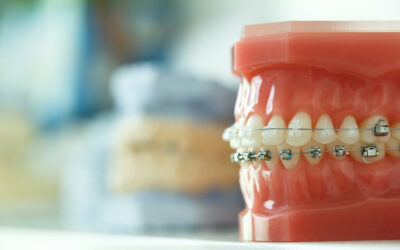The Pros and Cons of Metal Braces: Is It the Right Choice for You?

Advantages of Metal Braces
1. High Effectiveness in Complex Cases
Metal braces are particularly effective for correcting severe orthodontic issues. Whether it’s overcrowding, gaps, or complex bite problems like overbites or crossbites, metal braces can address these issues with precision. The brackets and wires apply consistent pressure, gradually moving teeth into their proper positions, making them ideal for patients needing significant orthodontic correction.
2. Cost-Effective
One of the biggest benefits of metal braces is their affordability. Compared to other orthodontic treatments like clear aligners or ceramic braces, metal braces are often more budget-friendly. This makes them accessible to a broader range of patients, ensuring that financial constraints don’t prevent anyone from achieving a healthy smile.
3. Durability
Metal braces are built to last. The metal brackets are strong and resistant to damage, meaning they can withstand the forces needed to realign teeth without frequent repairs. This durability ensures that your treatment progresses smoothly, minimizing disruptions and additional costs.
4. Versatility
Metal braces are versatile and capable of treating a wide range of dental issues, from minor adjustments to major corrections. This makes them a reliable choice for patients with multiple orthodontic concerns, as they can effectively address various problems simultaneously.
5. Proven Track Record
Metal braces have a long history of successful use in orthodontics. Their effectiveness is well-documented, providing both patients and orthodontists with confidence in the treatment’s ability to deliver desired results.
Drawbacks of Metal Braces
1. Noticeable Appearance
A common downside of metal braces is their visibility. Unlike clear aligners or ceramic braces, metal braces are more noticeable due to their metallic appearance. This can lead to self-consciousness, particularly in social situations, though many patients eventually become comfortable with their appearance.
2. Initial Discomfort
Wearing metal braces can be uncomfortable, especially in the beginning. Soreness in the teeth and gums is common as the braces start to shift the teeth. Additionally, the metal brackets and wires can irritate the soft tissues inside the mouth, leading to sores. These issues usually subside as the mouth adjusts, but discomfort is something to be aware of.
3. Dietary Restrictions
With metal braces, certain foods must be avoided to prevent damaging the brackets or wires. Hard, sticky, or crunchy foods, like popcorn or nuts, can pose a risk. While these dietary restrictions might seem inconvenient, they are necessary to ensure the treatment progresses without complications.
4. Increased Oral Hygiene Needs
Maintaining good oral hygiene is crucial when wearing metal braces. Food can easily get trapped in the brackets and wires, increasing the risk of plaque buildup and tooth decay. Patients must be diligent in brushing and flossing, often using specialized tools to clean effectively around the braces.
5. Longer Treatment Time
Metal braces often require a longer treatment duration compared to other options like clear aligners. The treatment involves regular adjustments by the orthodontist, which gradually guide the teeth into place. While this ensures precise results, it can be a drawback for those seeking a quicker solution.
Clear Braces vs. Metal Braces vs. Ceramic Braces
Deciding which type of braces is best for your orthodontic needs often involves comparing clear braces, metal braces, and ceramic braces. Each option has its unique advantages and considerations:
Appearance:
Clear and ceramic braces are designed to be less noticeable than metal braces. Clear braces use transparent materials, while ceramic braces feature tooth-colored brackets that blend with the natural color of your teeth. This makes them a popular choice for those who prefer a more discreet orthodontic treatment. In contrast, metal braces are more visible due to their metallic brackets and wires, which may be a concern for those who are self-conscious about their appearance.
Durability:
Metal braces are typically the most durable option. They are made from strong materials that can withstand the forces required to realign teeth without frequent repairs. On the other hand, ceramic braces, while aesthetically pleasing, are more prone to chipping or cracking under pressure. Clear braces, depending on the specific material used, can also be less durable than metal braces, potentially requiring more care to avoid damage.
Cost:
Cost is a significant factor when choosing between these options. Metal braces are usually the most affordable, making them accessible to a wider range of patients. Clear and ceramic braces tend to be more expensive due to the materials and the added benefit of being less visible. Patients should consider their budget alongside their aesthetic preferences when making a decision.
Treatment Time:
Treatment duration can vary between these types of braces. Metal braces are generally the most effective at exerting the necessary force to move teeth efficiently, potentially leading to a shorter treatment time. Clear and ceramic braces, while effective, may take longer because they often exert less force on the teeth. Patients seeking the quickest route to a straight smile might prefer metal braces for this reason.
Staining Potential:
Staining is another consideration, particularly with clear and ceramic braces. While advances in materials have reduced the likelihood of staining, it’s still possible, especially if proper oral hygiene isn’t maintained. Foods and drinks that cause staining, like coffee or red wine, can affect the appearance of clear and ceramic braces over time. Metal braces, being non-porous, are resistant to staining, making them a practical choice for those concerned about discoloration during treatment.
Making the Right Choice
When deciding between clear, metal, and ceramic braces, it’s essential to consider factors such as appearance, durability, cost, treatment time, and staining potential. Each type of braces has its benefits and drawbacks, and the right choice will depend on your specific dental needs, lifestyle, and personal preferences. Consulting with your orthodontist will help you weigh these options and choose the treatment that best aligns with your goals for a healthier, more confident smile.
Making the Right Choice
Choosing metal braces involves balancing their effectiveness and affordability with considerations like appearance and comfort. They are a reliable option for those needing significant orthodontic correction, but potential drawbacks such as visibility and discomfort should also be factored into your decision. Consulting with an orthodontist will help you make an informed choice that best suits your needs and leads to a healthier, more beautiful smile.



